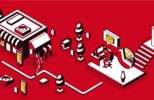How performance support is working at Deutsche Telekom Shared Services Europe

DTSE is a shared service unit of Deutsche Telekom AG, Germany’s largest telecommunications company. It combines the fields of HR, accounting, procurement and reporting under one roof and provides in-house services for the parent company. With its 3,300 employees, spread over a total of four countries, the company aims to offer the highest level of customer satisfaction, quality and innovation.
In 2016, DTSE consolidated many of its shared service center locations. As a result, a considerable volume of knowledge had to be preserved and transferred in a very short time, so that the services could be provided seamlessly at the new site.
Procurement and HR processes made easy
The tts performance suite test phase covered the fields of time management within Hire-to-Retire (HTR) and procure-to-pay (P2P). The trainer teams and users involved were introduced to the performance support solution and provided with access to the tts performance suite. A total of approximately ten processes were defined and transferred to the solution, which in itself dramatically reduced the outlay for formal training. Throughout, the DTSE teams were always able to rely on the support of Hamdi Tamiş, a consultant with tts. For example, author training and needs analysis were conducted and joint learning objects such as guidelines, documentation and eLearning courses based on existing process workflows at DTSE, including auditing and time sheets, were created.
Juliána Fegyveresová, KTM Tool Owner at DTSE
Whenever they have a question during their work with the software applications used by DTSE, they simply click on the magenta-colored orange icon in the task bar. Context-relevant information in various consumer-oriented formats such as step-by-step guides is then displayed automatically for the end users.
At the end of the test phase, everyone involved in the pilot project provided very positive feedback – from the content generation perspective, user-friendliness when recording an application, processing content or performing a partial update was outstanding. Those responsible for P2P and HTR then recommended further rollout and expansion of the tts performance suite within DTSE. One of the primary benefits highlighted was the QuickAccess end-user tool, a single point of access that offers up-to-date process documentation at any time on a company-wide, self-service basis. As Juliána Fegyveresová, KTM Tool Owner at DTSE, explains: “Our users actively utilize KTM in their everyday work. Whenever they have a question during their work with the software applications used by DTSE, they simply click on the magenta-colored orange icon in the task bar. Context-relevant information in various consumer-oriented formats such as step-by-step guides is then displayed automatically for the end users.” The knowledge is therefore no longer only stored in people’s heads, it is also saved to a central server and thus better protected from being lost through staff turnover. Furthermore, new employees can be more effectively inducted into the in-house processes and systems.
The knowledge pool is growing constantly thanks to committed staff
After the successful test phase, the tts performance suite was finally rolled out across DTSE in 2017. This involved introducing the performance support concept in eight national and international service lines. The SPOC team (single point of contact) met with representatives from all the service lines in a weekly web meeting to ensure a smooth implementation phase. SPOCs are the primary contact for authors and users in their own service line. The tts performance suite training requirements were covered by a combination of individual classroom training courses and, above all, virtual classrooms. By the second half of 2017, KTM was already a solid knowledge management tool, and more than 850 documents had been created.
During this time, the number of QuickAccess users not only grew constantly, there was also great interest in collaborating as authors, much to the delight of Juliána Fegyveresová. “The next version of KTM will include the option for user-generated content. This means it will be easy for end users to create a step-by-step guide for their co-workers without any additional training. This will further reduce the outlay for creating content.”
All the signs point to success
There are currently more than 200 authors involved in KTM and the tts performance suite, creating content for around 2,500 DTSE employees, including:
- Step-by-step guides, including animated screenshots
- eLearning courses with tests, videos and interactive units
- Other documents and attachments on relevant topics
The greatest effects of KTM at DTSE are, first of all, a significantly improved customer experience, since the training and support take less time and staff are interactively involved. Second, the solution takes a considerable load off key users and specialists in terms of responding to inquiries and conducting training.
The end-user components passed the accessibility tests required by the works council, which opens the door for a rollout across the entire Deutsche Telekom Group. Other potential users at Deutsche Telekom AG can conveniently access KTM for any IT application via the Telekom IT shop.
In addition to the option for user-generated content, the upcoming application upgrade is set to introduce handy push notifications that will provide users with information about the company’s current travel guidelines when they book their next business trip, for example. And that won’t be the end of it – in the future, Juliána Fegyveresová intends to continue operating as a committed Tool Owner to discover potential areas of application across the whole Deutsche Telekom Group and thus continue developing KTM.





